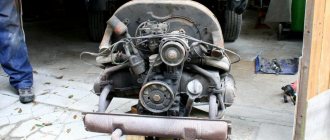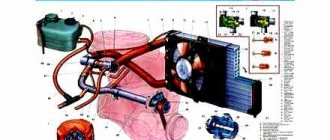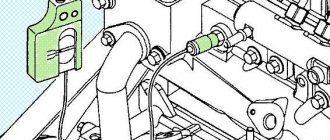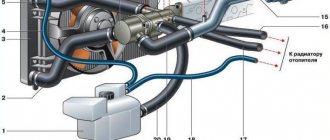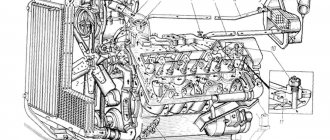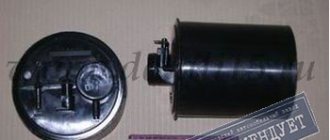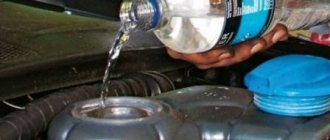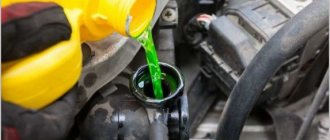Overheating of the internal combustion engine of ZMZ 409. Further actions.
During operation of the ZMZ-409 engine, a working cooling system maintains an optimal temperature regime in it, at which the normal temperature of the liquid in the system is within 80-90 degrees. A malfunction or malfunction of the cooling system can, and usually does, lead to engine overheating. If you miss this moment and do not take action in time, then unpleasant consequences in the form of complex, expensive repairs will be ensured.
Overheating of the ZMZ-409 engine, actions at the first signs of overheating.
At the first signs of engine overheating, when the coolant temperature on the gauges begins to rise, or the warning light on the lamp unit comes on, you must act quickly and decisively, but without unnecessary fuss. The manufacturer allows short-term, up to five minutes, engine operation when the coolant temperature rises to 109 degrees Celsius.
If there are no clouds of steam coming out from under the hood.
The absence of steam from under the hood when the engine overheats means maintaining the tightness of the cooling system and the initial actions in this case should be as follows: fully open the heater valve and the air intake damper, turn on the heater electric motor at maximum speed.
Then, turning on the hazard warning lights, depress the clutch pedal and using only the inertia of the car, carefully move it to the edge of the roadway and stop as far to the right as possible at the curb or even outside the roadway.
After stopping the car completely, do not turn off the engine immediately, but let it run for several minutes at idle speed with the heater engine turned on at full power, while constantly monitoring the coolant temperature. After at least some reduction in temperature, preferably as close as possible to the nominal temperature, the engine must be turned off.
If you turn off an overheated engine immediately, local overheating of the coolant will begin at the points of its contact with the most heat-stressed engine parts. This process will be accompanied by the formation of vapor locks, which will lead to thermal shock and, as a result, mandatory repairs.
If clouds of steam come out from under the hood.
This means that one of the cooling system hoses has burst or jumped off, or some other coolant leak has formed, so the engine must be stopped without delay.
Checking the cooling system after stopping an overheated engine.
After stopping the engine, you need to open the hood and carefully inspect the engine compartment for the presence of coolant in the expansion tank, the integrity of the rubber hoses, radiator, thermostat housing and determine the place where the steam was coming from. Inside the car, inspect the radiator and heater valve, as well as their hoses, for leaks or coolant drips.
We carry out an “X-ray” of the radiator
The cooling radiator itself is also a system of structural elements.
As such we will name:
- A fan is needed to increase air flow , thereby cooling the radiator core. It consists of a so-called “impeller” and a blade. The fan is turned on by a special temperature sensor.
- Centrifugal pump . This element forcibly moves fluid throughout the system. The components are a housing (made of aluminum), an impeller and an oil seal.
- Expansion tank , into which excess is delivered after the liquid is heated. It also serves as a channel for delivering fluid into the system.
- Thermostat . This is the engine temperature control sensor.
- "Water Shirt" . These are recesses inside the engine that serve as fluid circulation channels.
- Antifreeze , that is, the coolant itself, suitable for use even at low temperatures.
Cooling system diagram for ZMZ-402
It's quite simple. This power unit is cooled by liquid that passes through two circuits.
The system is built according to a ring scheme and consists of several main components. The liquid moves from the radiator through the pipes to the thermostat, then passes through the engine cooling jacket. Then, through the water pump, it returns to the radiator. In addition, the cooling system of the UAZ “Loaf” with a 402 engine includes an electric fan, a temperature sensor, and heaters. Let's look at each element separately.
Types of cooling systems UAZ Bukhanka
The operation of an internal combustion engine involves the generation of heat. For this reason, the cooling system of the UAZ Bukhanka 409 engine is designed to normalize the temperature regime inside the unit. This function is basic, since on modern engines cooling also performs additional tasks.
Overheating of the motor increases mechanical work, leading to loss of power, as it makes the filling of the chamber worse. Overheated parts independently ignite the working mixture, increasing wear, burning oil, reducing the mechanical properties of the material, rendering the engine unusable. Lack of heat causes fuel to condense on the walls and gradually flow into the oil pan. Lubricant dilution increases wear on rubbing parts, reducing engine power.
The difficulty of operating cooling is that the system maintains an acceptable mode, balancing between too little and too much heat. Ideally, the operating temperature is kept within 90°C.
Additional cooling features:
- Maintaining temperature in the stove, ventilation, air conditioning;
- Cooling the motor lubricant;
- Reducing the temperature in the combustion gas recirculation mechanism;
- Reducing the air temperature in the turbocharger of the engine;
- Reducing the temperature of the working fluid in the automatic transmission.
Due to the difficulty of maintaining a constant operating temperature, three types of cooling systems have been developed. Each type is used in proportion to the requirements for the motor and the conditions in which the unit will be operated.
- Liquid cooling (closed, open);
- Air cooling (natural, forced);
- Mixed cooling (hybrid).
Coolant system diagram
The design of the UAZ engine cooling system is quite simple; it is a closed type with forced circulation of coolant. The “coolant” circulates in a circle from the radiator, passing the water pump and thermostat into the cooling jacket, and then returns.
Let's consider the cooling scheme of the power unit on UAZs, and in particular on the engine marked 452:
Disadvantages of the UAZ Bukhanka cooling system
Despite the fact that the design of the cooling system of the ZMZ-409, UAZ-402 (421) engines is simple and reliable, the mechanism has inherent disadvantages. First of all, this refers to the quality of manufactured spare parts. Installation of insufficiently processed and adjusted parts reduces reliability and leads to breakdowns. In addition, on motors the fan speed is related to the pulley speed, which is not enough during hot periods. You can compensate for the lack of airflow by increasing the radiator capacity. However, the enlarged radiator is closed in cold weather, otherwise the engine will freeze. There are also complaints about the stove. The device requires additional pumping, without which there is not enough heat.
The problems can be resolved if the cooling is upgraded. The work includes replacing the radiator with a mechanism with a large number of sections. Installation of the second stove and other manipulations.
Air has entered the engine cooling system: the main signs of airing
For a better understanding, let's start with the general operating principles. While the engine is cold, the liquid circulates only through the cooling jacket (special channels in the cylinder block and cylinder head), without entering the radiator. Circulation is provided by a water pump.
After the coolant temperature reaches a certain value, the thermostat is activated, which opens a large circle (the liquid passes through the radiator). If cooling the coolant when driving in a large circle is not enough, then the engine cooling fan (air cooling) is automatically switched on.
Please note that these malfunctions can occur for various reasons, that is, the engine begins to overheat not only due to air locks, but this possibility should also not be excluded.
UAZ maintenance: fighting overheating
What primarily attracts domestic consumers to SUVs from the Ulyanovsk Automobile Plant? Perhaps the optimal combination of three such important factors as affordability, ideal adaptability to Russian off-road conditions and ease of maintenance. It is the latter that determines the demand for cars in remote regions and settlements, where UAZ repairs and maintenance have to be carried out primarily on their own, without relying on specialized UAZ service enterprises.
However, UAZ cars, despite their unpretentiousness, require constant care, especially if they constantly have to be used in difficult road conditions. And one of the most common troubles that causes a lot of trouble for drivers is engine overheating, which can lead to rapid wear and even failure. That is why, in order for the UAZ repair, instead of quickly eliminating current minor faults, not to turn into the “capital” of the heart of the car - the engine, the engine must be vigilantly protected from overheating.
The engine overheats most often in the hot season, and this can happen for various reasons, both at idle or driving at low speeds with increased loads, and on the highway, when the speed exceeds 70 km/h and there seems to be no reason to fear overheating.
These reasons, in general, are the same for both one and another case, despite the apparent difference in symptoms, and therefore the methods for eliminating them are similar.
1. Most often, overheating is a natural result of inefficient operation of the cooling system, and the most common and quickly removable malfunction is incomplete opening of the blinds. Everything here is quite simple: you need to clean and lubricate the drive mechanism.
2. The cooling system is dirty, the coolant has lost its properties. It is necessary to drain the unusable liquid, and then rinse the system for 5 minutes at idle (at operating temperature) with water with the addition of a special product for cleaning cooling systems (you can use the usual “Silit for dummies”). Drain the liquid again. Repeat the procedure 3-5 times, using just clean water. Finally, fill the system with fresh coolant.
Let's sum it up
In the end, I would like to note that the cooling system of every car, without exception, is extremely important for it, and it makes no difference whether it is a gasoline engine, like a 409 engine, or a diesel unit. Each motor will always need to remove high temperature so that the “heart” of the machine does not jam. It is for this reason that all car owners, including the UAZ Patriot, must actively monitor the proper operation of the unit so that no failures occur. Otherwise, when the temperature rises to more than 100 degrees, the engine stops untimely, and this is fatal for it, and for the driver too.
Read also: What kind of oil is poured into a hydraulic bottle jack
The ZMZ 409 engine was produced by the Zavolzhsky Motor Plant for vehicles produced at the Ulyanovsk Automobile Plant. Thus, UAZ cars received a modernized ZMZ 405 with some changes, namely a different shaped valve cover, an improved gas distribution mechanism and a new metal gasket.
troubleshooting
On any domestic car, problems periodically arise in the operation of electrical equipment. If you notice that the UAZ wiring is not working correctly, you need to diagnose it and check all the elements. If there are any malfunctions in the operation of electronic devices, first of all you need to check whether the fuses in the mounting block have burned out. If everything is fine with these elements, but the equipment still does not function, for example, if we talk about optics, then you need to check whether the light bulbs are working. If the lamps themselves are working, it is necessary to test the electrical part using a tester (the author of the video about testing car wiring is Ramil Abdullin).
If the Loaf refuses to start at all, you need to do the following:
Source
